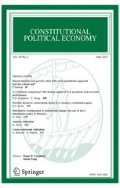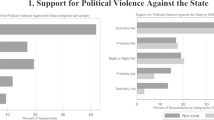Abstract
Several theories suggest that states’ choices of constitutional rules are at least partially a function of neighboring constitutions. This paper provides the first analysis of spatial dependence of specific provisions within state constitutions in the United States. The analysis effectively makes constitutional rules endogenous, contributing to a relatively underdeveloped branch of constitutional economics. By employing a series of probit estimations of nineteen specific constitutional rules, I find evidence of spatial dependence in state constitutions. Specifically, the presence of specific constitutional constraints pertaining to term limits, supreme court justice selection, recall, home rule, direct democracy, constitutional amendment by convention, balanced budget requirements, tax and expenditure limits, line item veto, victims’ bill of rights, health and welfare, right to privacy, environmental protection, sex discrimination, abortion, and official language all exhibit some evidence spatial dependence.


Similar content being viewed by others
Notes
An interesting unit of analysis for the study of this phenomenon would be cities which form along a state’s border. While such an undertaking is beyond the scope of the present paper, it would likely prove to be a worthwhile avenue for future research. I thank Donald Lacombe for this insight.
If X i is expressed in relative terms, it is not necessary to include X −i in Eq. 2.
Contiguity is determined using latitude and longitude coordinates and Delaunay triangles.
For example, the elements of w corresponding to Florida and Georgia takes a value of ‘1’ (since they share a common border) while the elements corresponding to Florida and Texas takes a value of ‘0’ (since they do not share a common border).
In general, former Confederate States have had a far greater number of constitutions than similarly-aged Northern states. Confederate States each adopted new constitutions following secession, asserting their place in the newly formed Confederate States of America. Following the end of the American Civil War, these states again adopted new constitutions rejoining the United States. Many adopted yet another constitution following Reconstruction.
A full description of the Gibbs sampler and Bayesian econometric technique employed is well beyond the scope of this paper. The interested reader is pointed to LeSage and Pace (2009) who provide a full treatment of the methodology. Fiva and Rattsø (2007) also provide an excellent summary of the procedure.
A full treatment of the Bayesian estimation of the spatial autoregressive probit model can be found in LeSage and Pace (2009) Chapter 10. The models were estimated using the ‘sarp_g’ function found in LeSage’s spatial econometrics toolbox, available at http://www.spatial-econometrics.com.
While the results are nearly identical, the time needed for computation increases greatly. As such, I present the results based on fewer MCMC draws as my primary findings.
Diffuse priors are also known as uninformative priors and indicate uncertainty about the expected values of the parameters. Specifically, the assumed prior mean for the β coefficients is zero, the prior variance of β is very large, and the parameter ρ has a range of [−1,1]. For more information on the role of priors in Bayesian estimation, see LeSage and Pace (2009).
References
Allers, M. A., & Elhorst, J. P. (2005). Tax mimicking and yardstick competition among local governments in The Netherlands. International Tax and Public Finance, 12, 493–513.
Bails, D., & Tieslau, M. A. (2000). The impact of fiscal constitutions on state and local expenditures. Cato Journal, 20(2), 255–277.
Benjamin, G. (1985). The diffusion of executive power in American state constitutions: Tenure and tenure limitations. Publius, 15(4), 71–84.
Besley, T. J., & Case, A. (1995a). Does electoral accountability affect economic policy choices? Evidence from gubernatorial term limits. Quarterly Journal of Economics, 110, 769–798.
Besley, T. J., & Case, A. (1995b). Incumbent behavior: Vote-seeking, tax-setting, and yardstick competition. American Economic Review, 85(1), 25–45.
Blume, L., Müller, J., Voigt, S., & Wolf, C. (2009). The economic effects of constitutions: Replicating-and extending-person and Tabellini. Public Choice, 139, 197–225.
Boix, C. (1999). Setting the rules of the game: The choice of electoral systems in advanced democracies. American Political Science Review, 93(3), 609–624.
Brennan, G., & Buchanan, J. M. (1977). Towards a tax constitution for leviathan. Journal of Public Economics, 8, 255–274.
Brennan, G., & Buchanan, J. M. (1978). Tax instruments as constraints on the disposition of public revenues. Journal of Public Economics, 9, 301–318.
Brennan, G., & Buchanan, J. M. (1980). The power to tax: Analytical foundations of a fiscal constitution. Cambridge: Cambridge University Press.
Brueckner, J. K. (2003). Strategic interaction among governments: An overview of empirical studies. International Regional Science Review, 26(2), 175–188.
Buchanan, J. M. (1975). The limits of liberty: Between anarchy and leviathan. Chicago: University of Chicago Press.
Buchanan, J. M. (1990). The domain of constitutional economics. Constitutional Political Economy, 1(1), 1–18.
Buchanan, J. M., & Tullock, G. (1962). The calculus of consent: Logical foundations of constitutional democracy. Ann Arbor: University of Michigan Press.
Caldeira, G. A. (1985). Constitutional change in america: Dynamics of ratification under article V. Publius, 15(4), 29–49.
Carter, J. R., & Schap, D. (1990). Line-item veto: Where is thy sing? Journal of Economic Perspectives, 4(2), 103–118.
Crowley, G. R., & Reece, W. S. (2012). Dynastic political privilege and electoral accountability: The case of US governors, 1950–2005. Mimeo.
Elhorst, J. P. (2009). Spatial panel data models. In M. Fischer & A. Getis (Eds.), Handbook of applied spatial analysis. Berlin: Springer.
Elkins, Z., & Simmons, B. (2005). On waves, clusters, and diffusion: A conceptual framework. The Annals of the American Academy of Political and Social Science, 598(1), 33–51.
Fiva, J. H., & Rattsø, J. (2007). Local choice of property taxation: Evidence from Norway. Public Choice, 132, 457–470.
Garrett, T. A., Wagner, G. A., & Wheelock, D. C. (2005). A spatial analysis of state banking regulation. Papers in Regional Science, 84(4), 575–595.
Gray, V. (1973). Innovation in the states: A diffusion study. American Political Science Review, 67(4), 1174–1185.
Hall, J. C., & Ross, J. M. (2010). Tiebout competition, Yardstick competition, and Tax instrument choice: Evidence from Ohio School Districts. Public Finance Review, 38(6), 710–737.
Holcombe, R. G. (1991). Constitutions as constraints: A case study of three American constitutions. Constitutional Political Economy, 2(3), 303–328.
Holcombe, R. G. (1992). The distributive model of government: Evidence from the confederate constitution. Southern Economic Journal, 58(3), 762–769.
Holcombe, R. G. (1994). The Distinction between Clubs and Governments. Chapter 5 in The Economic Foundations of Government. New York: NYU Press.
Holcombe, R. G. (1998). Constitutional theory and the constitutional history of colonial America. The Independent Review, 3(1), 21–36.
Holtz-Eakin, D. (1988). The line item veto and public sector budgets: Evidence from the states. Journal of Public Economics, 36(3), 269–292.
Kimenyi, M. S., & Shughart II, W. F. (2010). The political economy of constitutional choice: A study of the 2005 Kenyan constitutional referendum. Constitutional Political Economy, 21(1), 1–27.
LeSage, J., & Pace, R. K. (2009). Introduction to spatial econometrics. Boca Raton: CRC Press.
Maddex, R. L. (1998). State constitutions of the United States. Washington, DC: CQ Press.
Maddex, R. L. (2003). State constitutions of the United States (2nd ed.). Washington, DC: CQ Press.
Matsusaka, J. G. (1995). Fiscal effects of the voter initiative: Evidence from the last 30 years. Journal of Political Economy, 103(3), 587–623.
Matsusaka, J. G. (2000). Fiscal effects of the voter initiative in the first half of the twentieth century. Journal of Law and Economics, 43(2), 619–650.
Matsusaka, J. G. (2005). Direct democracy works. Journal of Economic Perspectives, 19(2), 185–206.
Matsusaka, J. G., & McCarty, N. M. (2001). Political resource allocation: Benefits and costs of voter initiatives. The Journal of Law, Economics, and Organization, 17(2), 413–448.
McGuire, R. A. (1988). Constitution making: A rational choice model of the federal convention of 1787. American Journal of Political Science, 32(2), 438–522.
McGuire, R. A., & Ohsfeldt, R. L. (1984). Economic interests and the American constitution: A quantitative rehabilitation of Charles A. Beard. Journal of Economic History, 44(2), 509–519.
McGuire, R. A., & Ohsfeldt, R. L. (1986). An economic model of voting behavior over specific issues at the constitutional convention of 1787. Journal of Economic History, 46(1), 79–111.
McGuire, R. A., & Ohsfeldt, R. L. (1989). Self-Interest, agency theory, and political voting behavior: The ratification of the US constitution. American Economic Review, 79(1), 219–234.
McGuire, R. A., & Ohsfeldt, R. L. (1997). Constitutional economics and the American founding. Research in Law and Economics, 18, 143–171.
Persson, T., & Tabellini, G. (2002). Do constitutions cause large governments? Quasi-experimental evidence. European Economic Review, 46, 908–918.
Persson, T., & Tabellini, G. (2003). The economic effects of constitutions. Cambridge, MA: MIT Press.
Persson, T., & Tabellini, G. (2004). Constitutional rules and fiscal policy outcomes. American Economic Review, 94(1), 25–45.
Poterba, J. M. (1994). State responses to fiscal crises: The effects of budgetary institutions and politics. Journal of Political Economy, 102(4), 799–821.
Poterba, J. M. (1996). Budget institutions and fiscal policy in the US states. American Economic Review, 86(2), 395–400.
Puro, M., Bergerson, P. J., & Puro, S. (1985). An analysis of judicial diffusion: Adoption of the missouri plan in the American States. Publius, 15(4), 85–97.
Salmon, P. (1987). Decentralization as an incentive sheme. Oxford Review of Economic Policy, 3(2), 24–43.
Salzberger, E. M., & Voigt, S. (2002). On the delegation of powers: With special emphasis on Central and Eastern Europe. Constitutional Political Economy, 13(1), 25–52.
Severson K (2011) North Carolina voters to decide on same-sex marriage. New York Times, September 13, 2011. http://www.nytimes.com/2011/09/14/us/north-carolina-voters-to-decide-on-same-sex-marriage.html.
Stonecash, J. M. (1983). Fiscal centralization in the American States: Increasing similarity and persisting diversity. Publius, 13, 123–137.
Tarr, G. A. (1992). Understanding state constitutions. Temple Law Review, 65, 1169–1195.
Tarr, G. A. (1996). Constitutional politics in the states: Contemporary controversies and historical patterns. Westport, CT: Greenwood Press.
Tarr, G. A. (1998). Understanding state constitutions. Princeton: Princeton University Press.
Tiebout, C. M. (1956). A pure theory of local expenditures. Journal of Political Economy, 64(5), 416–424.
Voigt, S. (1997). Positive constitutional economics: A survey. Public Choice, 90(1–4), 11–53.
Voigt, S. (2011). Positive constitutional economics II: A survey of recent developments. Public Choice, 146(1–2), 205–256.
Wagner, G. A., & Sobel, R. S. (2006). State budget stabilization fund adoption: Preparing for the next recession or circumventing fiscal constraints? Public Choice, 126, 177–199.
Walker, J. L. (1969). The diffusion of innovations among the American States. American Political Science Review, 63(3), 880–899.
Wibbels, E. (2005). Decentralized governance, constitution formation, and redistribution. Constitutional Political Economy, 16, 161–188.
Acknowledgments
I thank Russell Sobel, Scott Beaulier, Brian Cushing, Tami Gurley-Calvez, Donald Lacombe, James LeSage, Santiago Pinto, William Reece, two anonymous referees, and participants at the 2011 meetings of the Public Choice Society in San Antonio, TX, and Association of Private Enterprise Education in Nassau, Bahamas for helpful comments.
Author information
Authors and Affiliations
Corresponding author
Rights and permissions
About this article
Cite this article
Crowley, G.R. Spatial dependence in constitutional constraints: the case of US states. Const Polit Econ 23, 134–165 (2012). https://doi.org/10.1007/s10602-012-9117-4
Published:
Issue Date:
DOI: https://doi.org/10.1007/s10602-012-9117-4




